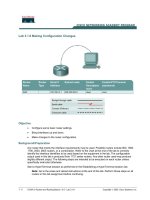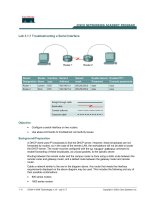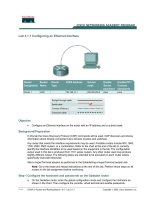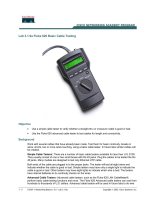Tài liệu Lab 3.1.9b Fluke 620 Basic Cable Testing doc
Bạn đang xem bản rút gọn của tài liệu. Xem và tải ngay bản đầy đủ của tài liệu tại đây (135.96 KB, 2 trang )
Lab 3.1.9b Fluke 620 Basic Cable Testing
Objective
• Use a simple cable tester to verify whether a straight-thru or crossover cable is good or bad.
• Use the Fluke 620 advanced cable tester to test cables for length and connectivity.
Background
Work with several cables that have already been made. Test them for basic continuity, breaks in
wires, shorts, two or more wires touching, using a basic cable tester. In future labs similar cables will
be created.
Simple Cable Testers: There are a number of basic cable testers available for less than U.S. $100.
They usually consist of one or two small boxes with RJ-45 jacks. Plug the cables to be tested the RJ-
45 jacks. Many models are designed to test only Ethernet UTP cable.
Both ends of the cable are plugged in to the proper jacks. The tester will test all eight wires and
indicate whether the cable is good or bad. Simple testers may have only a single light to indicate the
cable is good or bad. Other testers may have eight lights to indicate which wire is bad. The testers
have internal batteries to do continuity checks on the wires.
Advanced Cable Testers: Advanced cable testers, such as the Fluke 620 LAN CableMeter®,
perform basic cable testing functions and more. The Fluke 620 Advanced cable testers can cost from
hundreds to thousands of U.S. dollars. Advanced cable testers will be used in future labs to do wire
1 - 2 CCNA 1: Networking Basics v 3.0 - Lab 3.1.9b Copyright 2003, Cisco Systems, Inc.
maps as well as other tasks. The 620 LAN CableMeter is a cable tester designed to verify
connectivity of all LAN cable types. This rugged tester can measure cable length, test for faults and
show the distance to the defect. Open faults include opens, shorts, reversed, crossed, or split pairs.
Each 620 LAN CableMeter comes with one cable identifier.
The Fluke 620 is more advanced because it performs more functions:
• Requires only single-person verification
• Tests all LAN cable types, UTP, STP, FTP, Coax
• Detects a multitude of wiring problems including open, short, crossed, reversed, split pair
• Locates wiring or connection errors
• Measures cable length
Prior to starting the lab, the teacher or lab assistant should have basic cable testers or Fluke Cable
meters available for each team of students. Also provided should be various lengths of wire with
induced problems. Work in teams of two. The following resources will be required:
• Basic cable tester
• Advanced cable tester, Fluke 620 or an equivalent
• Two good CAT 5 or higher cables, one crossover and one straight-thru
• Two bad CAT 5 or higher cables, one with a break and one with a short. Use different colors or
labels.
Step 1 Test the Cables
Simple cable tester: Refer to the instructions from the manufacturer. Insert the ends of the cable to
be tested into the jacks according to the instructions.
Fluke 620: Insert the RJ-45 from one end of the cable into the UTP/FTP jack on the tester. Turn the
dial to test. All conductors will be tested to verify they are not broken or shorted.
Note: This test does not verify that the pins are connected correctly from one end to the
other.
For each test, insert the cable into the RJ-45 jack(s) of the cable tester. Record the results in the
following table.
Color or Cable
number
Category
Type
Straight-through or
crossover?
Length of
cable
Test results
Cable #1
Cable #2
Cable #3
Cable #4
Cable #5
2 - 2 CCNA 1: Networking Basics v 3.0 - Lab 3.1.9b Copyright 2003, Cisco Systems, Inc.









